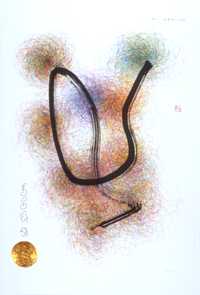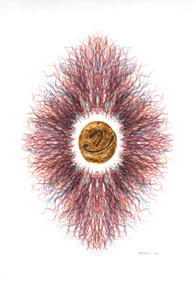![]()

From the issue dated March 2, 2001
|
END PAPER
Machine-Made Works That Look Crafted by Hand
He describes himself as part of a group of artists known as algorists. As such, his vision is not focused solely on the ink and paper that form his finished prints. To be sure, there is a marvelous expressiveness in his lines -- from the fluidly eloquent Oriental brush strokes in his "Nested Swallow," to the glasslike translucence in the petals of his "Cyberflowers." Yet these are just the outer surface of his art. The heart of his work is hidden in the computer programs he writes to produce images that often seem created by hand. A pen plotter that has been adapted to print with artist's brushes and pens is used for printing. The code is reworked by the artist and by the machine for each image, making each one unique. An algorithm is a set of actions or procedures, whether mechanical or organic, Verostko says. It may produce a monument like Stonehenge, or the radial pattern of seeds in a sunflower. One of his works may be based on a single stroke that has been repeated with variations in color, position, and size. The result is a dazzling texture of intertwining layers, with clouds of jewel-like tones that belie the fact his palette contains only five colors of ink. When he stands off from a drawing to look at it and the colors start to shimmer, Verostko says he knows he has achieved what he wants. Verostko has referred to the code that creates his work as the "score." Nonetheless, it is not a techno-pop effect he is after, but one rich with echoes of the medieval art he loves. ... Always, the signature of his personal style emerges through the machine. His current work reflects the same sensibility he has as a painter, Verostko says. From constructivism, and the Realist Manifesto of Naum Gabo and Antoine Prevsner, he has taken the ideas of kinetic rhythms and the reality of objects. From the "random walk" sensibility of Jackson Pollock's drip paintings, and the cool, jazzlike variations of Piet Mondrian, he has developed an appreciation for dynamic equilibrium, for the tension between chaos and order. The artwork is by Roman Verostko, a professor emeritus
of art history at the Minneapolis College of Art and Design. His artwork
can be seen in the exhibition "Algorithmic Fine Art," at Arizona State
University's Computing Commons Gallery through March 9. The text above
is by the writer Kolleen Roberts. To view the entire exhibition online,
see http://www.verostko.com/shows/tempe/tempe.html
For information about the artist, see http://www.penplot.com/ http://chronicle.com Section: The Chronicle Review Page: B19 |
|||||||||||
Copyright © 2001 by The Chronicle of Higher Education. This article may not be published, reposted, or redistributed without express permission from The Chronicle. To obtain such permission, please send a message to permission@chronicle.com. For subscription information, send a message to circulation@chronicle.com.

